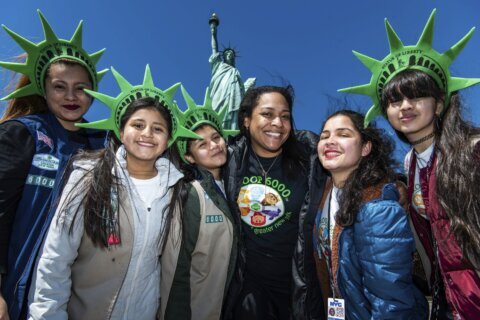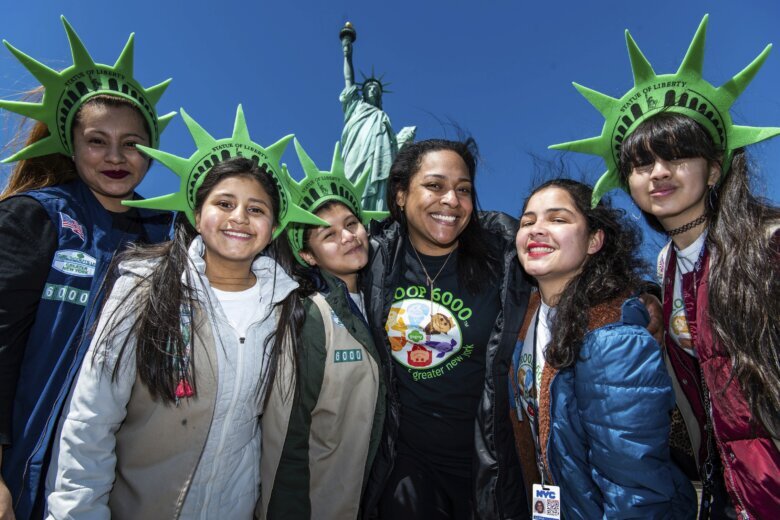
NEW YORK (AP) — Once a week in a midtown Manhattan hotel, dozens of Girl Scouts gather in a spare room made homey by string lights and children’s drawings. They earn badges, go on field trips to the Statue of Liberty, and learn how to navigate the subway in a city most have just begun to call home.
They are the newest members of New York City’s largest Girl Scout troop. And they live in an emergency shelter where 170,000 asylum seekers and migrants, including tens of thousands of children, have arrived from the southern border since the spring of 2022.
As government officials debate how to handle the influx of new arrivals, the Girl Scouts — whose Troop 6000 has served kids who live in the shelter system since 2017 — are quietly welcoming hundreds of the city’s youngest new residents with the support of donations. Most of the girls have fled dire conditions in South and Central America and endured an arduous journey to the U.S.
Not everybody is happy about the evolution of Troop 6000. With anti-immigrant rhetoric on the rise and a contentious election ahead, some donors see the Girl Scouts as wading too readily into politically controversial waters. That hasn’t fazed the group — or their small army of philanthropic supporters. Amid city budget cuts and a growing need for services, they are among dozens of charities that say their support for all New Yorkers, including newcomers, is more important than ever.
“If it has to do with young girls in New York City, then it’s not political,” said Meridith Maskara, CEO of the Girl Scouts of Greater New York. “It’s our job.”
While Troop 6000 has found plenty of sympathetic supporters, “there are some donors who would prefer their dollars go elsewhere,” says Maskara. “I am constantly being asked: Don’t you find this a little too political?”
‘Who’s gonna give us a chance?’
Last year, Troop 6000 opened its newest branch at a hotel-turned-shelter in Midtown Manhattan, one of several city-funded relief centers for migrants. Though hundreds of families sleep at the shelter every night, the Girl Scouts is the only children’s program offered.
Perhaps that’s what’s made the troop so popular.
Last January, the group began recruiting at the shelter and rolled out a bilingual curriculum to help scouts learn more about New York City through its monuments, subway system, and political borders.
One year later, with nearly 200 members and five parents as troop leaders, the shelter is the largest of Troop 6000’s roughly two dozen sites across the city and the only one exclusively for asylum-seekers.
With few other after-school opportunities available, the girls are “so hungry for more” ways to get involved, says Giselle Burgess, senior director of the Girl Scouts of New York’s Troop 6000.
Seven years ago, Burgess, a single mother of six, built Troop 6000 from the ground up after losing her rental home to developers. While living in a hotel-turned-shelter, she got the idea of creating a troop for girls like her daughters. It was the height of “NIMBYism,” she says, the not-in-my-backyard movement opposed to local homeless shelters.
At the time, she asked: “Who’s gonna give us a chance?”
As it turns out, “the donations started pouring in,” she says. A New York Times profile lead to a groundswell of philanthropy — plus tens of thousands of dollars in cookie sales — that helped the group grow from seven girls at a shelter in Queens to more than 2,500 scouts and troop leaders at over 20 temporary housing sites across the city.
So, when the mayor’s office floated the idea of starting a troop at the Midtown shelter, the Girl Scouts were ready.
“We already had a model that has really proven to work,” says Maskara, who raised about $400,000 in an emergency campaign from Trinity Church Wall Street Philanthropies, the Horace W. Goldsmith Foundation, and the Steven & Alexandra Cohen Foundation.
Troop 6000 employs bilingual social workers and a transition specialist versed in supporting children who’ve experienced trauma. But otherwise, it operates much like any other Girl Scout troop.
Most importantly, says Maskara, the troop offers a glimmer of consistency to children who often must pack up, move homes, and switch schools in the middle of the academic year. Scouts are encouraged to continue participating even when their families move.
That hasn’t been easy at the Midtown shelter. The average length of stay for a family in the city’s homeless shelter system is a year and a half; in an emergency shelter, it’s often mere months. At least 40 families have been evicted from the Midtown shelter since January.
“Keeping the girls connected is what matters the most for us right now,” says Burgess. “There’s a lot of emotion, frustration, and hurt.” Around 50 scouts who have left the shelter participate in a virtual troop.
“We want to be able to encourage the girls and let them know it’s not over,” she says. “We’re still here.”
Philanthropy steps in
New York City has spent billions on the asylum seekers while buckling under the pressure of an existing housing and affordability crisis. That’s left little time to court and coordinate the city’s major philanthropies.
“It’s very hard to take a step back when you’re drinking out of a fire hose,” says Beatriz de la Torre, chief philanthropy officer at Trinity Church Wall Street, which gave the Girl Scouts a $100,000 emergency grant — plus $150,000 in annual support — to help expand Troop 6000.
With or without government directives, she says, charities are feeling the crunch: Food banks need more food. Legal clinics need more lawyers.
Since asylum-seekers began arriving to the city, around 30 local grant makers, including Trinity Church and Brooklyn Org, have met at least biweekly to discuss the increased demands on their grantees.
Together, they’ve provided over $25 million for charities serving asylum seekers, from free legal assistance to resources for navigating the public school system.
“It’s hard for the government to be that nimble — that’s a great place for nonprofits and philanthropy,” says Eve Stotland, senior program officer at New York Community Trust, which convenes the Working Group for New York’s Newcomers, and itself has distributed over $2.7 million in grants for recent immigrants.
“These are our neighbors,” says Stotland. “If a funder’s goal is to make New York City a better place for everyone, that includes newcomers.”
Political backlash
In a typical year, funding for immigrants makes up a “very, very small” percentage of overall grant making, says Marissa Tirona, president of Grantmakers Concerned with Immigrants and Refugees, and funding for immigrants actually shrunk 11% from 2012 to 2020.
During an election year, services for immigrants might be even more at risk.
“Migrant families are often used as political pawns,” and some donors may succumb to anti-immigrant fear-mongering, says Tirona.
The Girl Scouts have not been immune to the backlash, nor is it the first time they’ve shouldered criticism from conservative donors.
While Troop 6000 has not been deterred, Maskara says that many of her peers in the nonprofit world have been fearful to publicly support newcomers.
“What holds them back is the appearance of being too progressive or too political,” she says. “My response to them is: You have no idea how many doors it will open.”
_____
Sara Herschander is a reporter at the Chronicle of Philanthropy, where you can read the full article. This article was provided to The Associated Press by the Chronicle of Philanthropy as part of a partnership to cover philanthropy and nonprofits supported by the Lilly Endowment. The Chronicle is solely responsible for the content. For all of AP’s philanthropy coverage, visit https://apnews.com/hub/philanthropy.
Copyright © 2024 The Associated Press. All rights reserved. This material may not be published, broadcast, written or redistributed.








